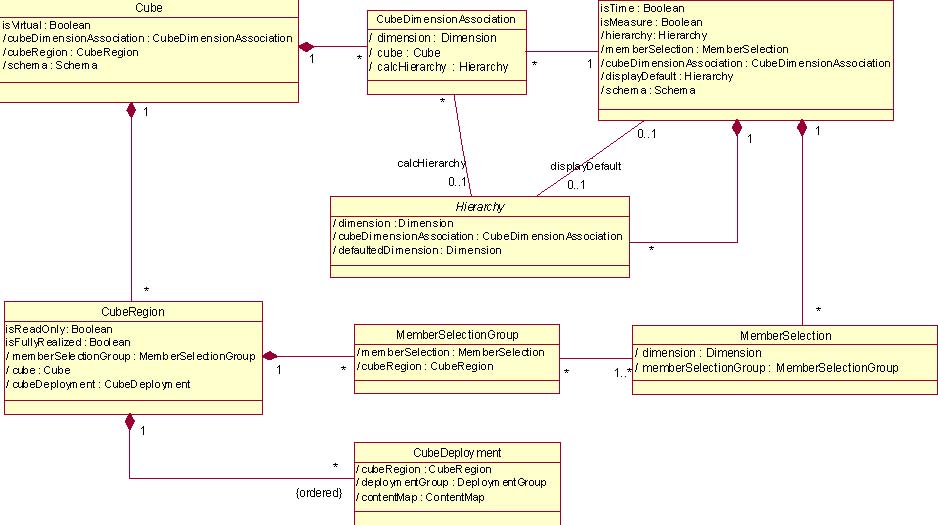
| Previous | Table of Contents | Next |
Schema





Dimension Cube
CubeDimensionAssociation








calcHierarchy

displayDefault

Hierarchy



CubeRegion

MemberSelectionGroup MemberSelection




CubeDeployment

{ordered}

Figure 11-1 OLAP Metamodel: Major Classes and Associations
The major classes and associations of the OLAP metamodel are shown in
Figure 11-1
.
Schema is the logical container of all elements comprising an OLAP model. It is the root element of the model hierarchy and
marks the entry point for navigating OLAP models.
March 2003 OMG-CWM, v1.1: Organization of the OLAP Package
A Schema contains Dimensions and Cubes. A Dimension is an ordinate within a multidimensional structure and consists of a list
of unique values; that is, members that share a common semantic meaning within the domain being modeled. Each member designates
a unique position along its ordinate.
A Cube is a collection of analytic values; that is, measures that share the same dimensionality. This dimensionality is specified
by a set of unique Dimensions from the Schema. Each unique combination of members in the Cartesian product of the Cube’s Dimensions
identifies precisely one data cell within a multidimensional structure.
CubeDimensionAssociation relates a Cube to its defining Dimensions. Features relevant to Cube-Dimension relationships (for
example, calcHierarchy) are exposed by this class.
A Dimension has zero or more Hierarchies. A Hierarchy is an organizational structure that describes a traversal pattern through
a Dimension, based on parent/child relationships between members of a Dimension. Hierarchies are used to define both navigational
and consolidation/computational paths through the Dimension; that is, a value associated with a child member is aggregated
by one or more parents. For example, a Time Dimension with a base periodicity of days might have a Hierarchy specifying the
consolidation of days into weeks, weeks into months, months into quarters, and quarters into years.
A specific Hierarchy may be designated as the default Hierarchy for display purposes (for example, a user interface that displays
the Dimension as a hierarchical tree of members). CubeDimensionAssociation can also identify a particular Hierarchy as the
default Hierarchy for consolidation calculations performed on the Cube.
Dimensions and Hierarchies are described further in Section 11.3.3, “Dimension and
Hierarchy,? on page 11-5.
MemberSelection models mechanisms capable of partitioning a Dimension’s collection of members. For example, consider a Geography
Dimension with members representing cities, states, and regions. An OLAP client interested specifically in cities might define
an instance of MemberSelection that extracts the city members.
CubeRegion models a sub-unit of a Cube that is of the same dimensionality as the Cube itself. Each “dimension? of a CubeRegion
is represented by a MemberSelection of the corresponding Dimension of the Cube. Each MemberSelection may define some subset
of its Dimension’s members.
CubeRegions are used to implement Cubes. A Cube may be realized by a set of CubeRegions that map portions of the logical Cube
to physical data sources. The MemberSelections defining CubeRegions can also be grouped together via MemberSelectionGroups,
enabling the definition of CubeRegions with specific semantics. For example, one can specify a CubeRegion containing only
the “input level? data cells of a Cube.
A CubeRegion may own any number of CubeDeployments. CubeDeployment is a metaclass that represents an implementation strategy
for a multidimensional structure. The ordering of the CubeDeployment classes may optionally be given some implementation-specific
meaning (for example, desired order of selection of several possible deployment strategies, based on optimization considerations).